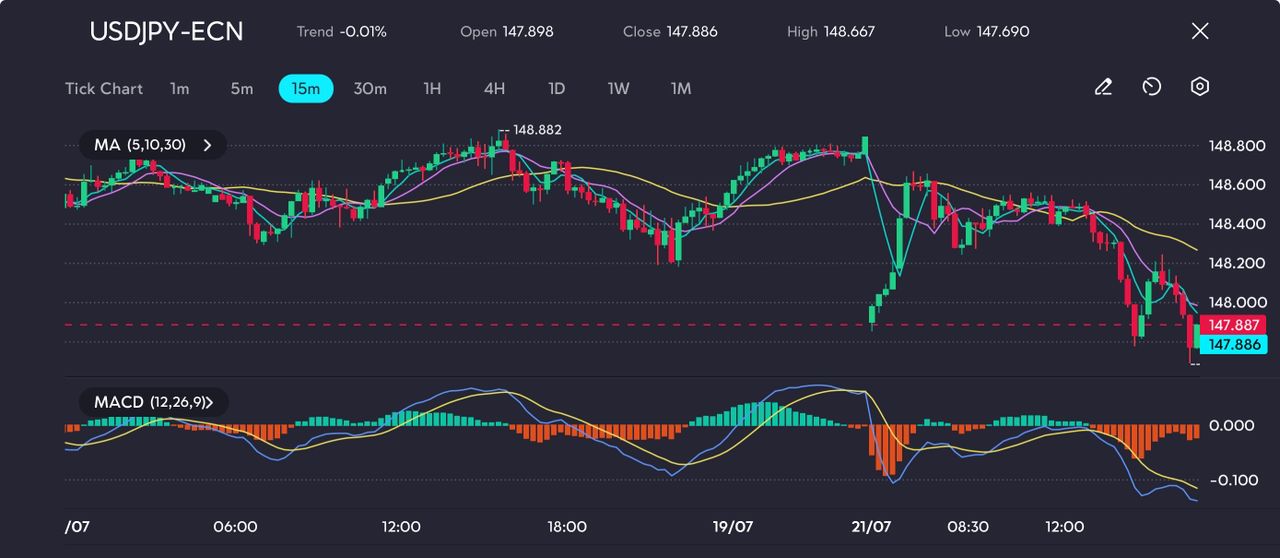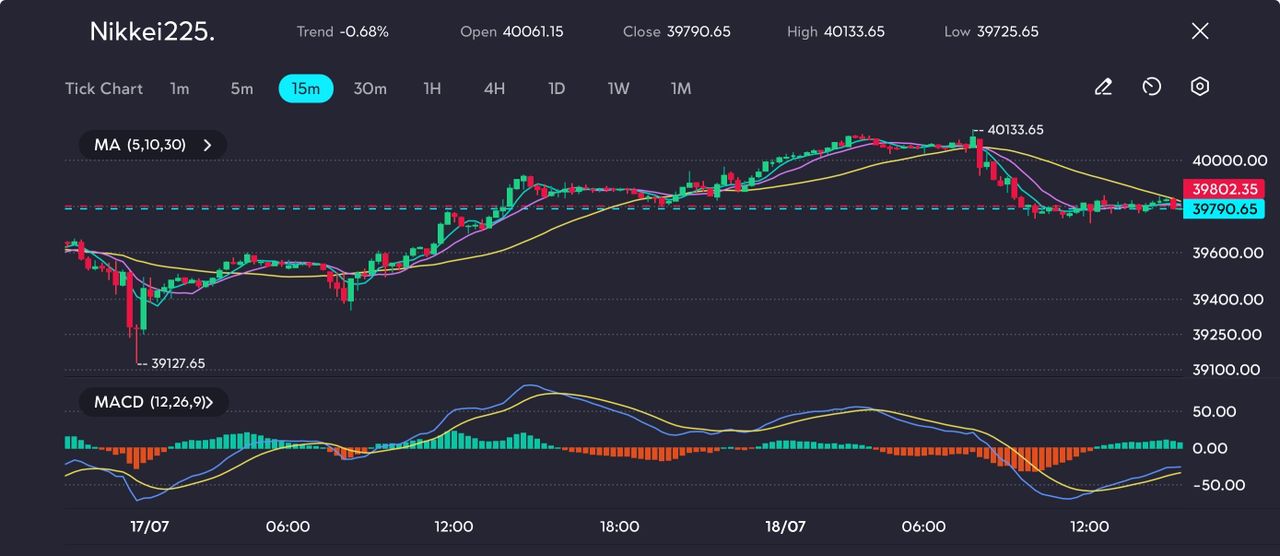The Simple Moving Average (SMA) is a popular tool in trading, helping traders filter out market noise and identify underlying trends by averaging prices over a specific period. In this article, we’ll explain what the SMA is, how to calculate it, and how it can be applied in various trading strategies to improve your decision-making.
What is the Simple Moving Average?
A Simple Moving Average (SMA) is one of the most commonly used tools in technical analysis, helping traders identify trends by smoothing out price fluctuations. It is a type of moving average that calculates the average price of an asset over a specified number of periods, making it a straightforward yet effective method for tracking market movements.
The Simple Moving Average is called ‘simple’ because it takes an unweighted average of prices over the selected period. This easy-to-understand indicator highlights trends in price data, helping traders make informed decisions.
Formula for Simple Moving Average (SMA)
The formula for calculating the Simple Moving Average is:
Simple Moving Average = (Sum of Prices) / (Number of Periods)
Where:
- Sum of Prices refers to the total of the closing prices for each period you’re analyzing (e.g., the sum of the closing prices for the last 10 days),
- Number of Periods is the number of data points you are averaging (e.g., 10 days for a 10-day SMA).
This formula simply averages the closing prices over a specific time frame, providing a smoothed line that represents the asset’s price over the chosen period.
How to Calculate Simple Moving Average
To calculate the Simple Moving Average, follow these steps:
- Choose a time: Decide on the number of periods for which you want to calculate the average (e.g., 5, 10, 50, or 200 days).
- Collect the data: Gather the closing prices for each period. For example, if you’re calculating a 10-day SMA, collect the last 10 closing prices.
- Add up the closing prices: Add the closing prices of all the periods you’re analyzing.
- Divide by the number of periods: Divide the sum of the prices by the number of periods (e.g., 10 for a 10-day SMA).
Example:
Let’s calculate a 10-day SMA with the following data:
- Day 1: Price = $20
- Day 2: Price = $22
- Day 3: Price = $24
- Day 4: Price = $26
- Day 5: Price = $28
- Day 6: Price = $30
- Day 7: Price = $32
- Day 8: Price = $34
- Day 9: Price = $36
- Day 10: Price = $38
Calculate the 10-day SMA (the average of the last 10 closing prices):
SMA = (20 + 22 + 24 + 26 + 28 + 30 + 32 + 34 + 36 + 38) / 10
SMA = 290 / 10 = 29
So, the 10-day Simple Moving Average (SMA) is $29.
How to Use Simple Moving Average in Trading
The Simple Moving Average (SMA) is an essential tool for traders, helping to identify trends, determine support and resistance levels, and guide trading decisions. Here’s how to use the SMA in different market scenarios:
1. Trend Identification
The Simple Moving Average is an effective tool for identifying market trends by averaging price data over a specified period. A rising SMA indicates an upward trend, while a declining SMA points to a downward trend. Traders use the SMA to validate trends and avoid false signals.
Example: In the stock market, when Microsoft (MSFT) is trading above its 50-day SMA, it suggests that the stock is in an uptrend. If the 50-day SMA crosses above the 200-day SMA, it can signal the beginning of a strong bullish move. Conversely, if the stock price drops below its SMA, it could indicate the reversal of the trend and potential bearish conditions, giving traders a chance to act before the trend fully shifts.
2. Support and Resistance
The Simple Moving Average (SMA) acts as dynamic support and resistance. When prices are above the moving average, the SMA can act as support, with the price bouncing upwards when it approaches the SMA. On the other hand, when the price is below the SMA, it may act as resistance, preventing upward movement.
Example: In forex trading, the major currency pair, EUR/USD, frequently uses the 100-day SMA as a dynamic support level. When the price retraces towards the 100-day SMA and finds support there, traders may see this as a signal to buy. If the price drops below this level, the SMA could turn into resistance, signaling a possible downward trend, and traders may decide to exit or short the pair.
3. Crossovers
The SMA crossover strategy is a popular approach for identifying potential entry and exit points. A bullish crossover (Golden Cross) occurs when a shorter-term SMA crosses above a longer-term SMA, suggesting an upward momentum. The opposite, a bearish crossover (Death Cross), occurs when the short-term SMA crosses below the long-term SMA, signaling a potential downtrend.
Example: For precious metals, like gold (XAUUSD), traders often watch the 50-day SMA and the 200-day SMA. In 2024, when the 50-day SMA crossed above the 200-day SMA for gold, it signaled the beginning of a bullish trend, encouraging traders to take long positions. A crossover like this is considered a strong buy signal in commodities, as it suggests that the price may continue to rise.
Learn the key differences between long and short positions.
What Are the Differences Between SMA and EMA?
The key difference between the Simple Moving Average (SMA) and the Exponential Moving Average (EMA) lies in how they handle price data:
- Weighting: The SMA treats all prices equally, while the EMA gives more weight to recent prices.
- Responsiveness: The SMA reacts more slowly to recent price changes, making it a smoother, more stable indicator. In contrast, the EMA is more responsive and quicker to react to price changes.
- Lagging vs. Leading Indicator: The SMA is a lagging indicator, meaning it takes longer to react to price changes. The EMA, being more sensitive to recent prices, acts as a leading indicator and can provide earlier signals.
- Smoothing Effect: The SMA offers a smoother and more stable line by averaging all prices evenly. The EMA is less smooth and reacts more sharply to price movements, making it ideal for capturing rapid market changes.
The SMA is more suitable for identifying long-term trends and providing a stable, averaged perspective on price movement. The EMA, on the other hand, is better for short-term trading strategies that require quick reactions to price changes and market shifts.
Common Mistakes to Avoid When Using SMA
While the Simple Moving Average is a powerful tool, there are several common mistakes traders should avoid:
- Over-reliance on SMA: Many traders make the mistake of relying solely on the SMA for decision-making. It’s important to use it in conjunction with other technical indicators like RSI, MACD, or Bollinger Bands for more reliable signals.
- Ignoring Market Volatility: SMA can lag during periods of high volatility. Traders who ignore market conditions may misinterpret signals. For instance, during volatile market events, the SMA might not react quickly enough to changes in direction.
- Choosing the Wrong Timeframe: Using an SMA that is too short (e.g., a 5-day SMA) can lead to false signals during choppy markets. It’s important to choose an SMA time that aligns with your trading strategy.
- Not Accounting for Market News: While SMA is a valuable tool, it doesn’t account for fundamental factors like earnings reports, news events, or economic data. These can influence the price and may cause the SMA to lag behind the market.
- Ignoring Price Action: Traders sometimes focus too much on the SMA and overlook the price action itself. Price patterns, candlestick formations, and trendlines are just as crucial in confirming signals from the SMA. Relying solely on the SMA without considering price action can lead to missed opportunities or false entries.
In Summary
The Simple Moving Average (SMA) is an effective tool for identifying trends and acting as dynamic support or resistance. However, while useful, the SMA should be combined with other indicators, such as RSI or MACD, to provide more reliable trading signals. Avoiding common mistakes like over-reliance on the SMA and ignoring market conditions will help traders use it more effectively in their strategies.
Start Trading Today with VT Markets
Ready to put your knowledge of the Simple Moving Average to the test? VT Markets provides access to MetaTrader 4 (MT4) and MetaTrader 5 (MT5), offering advanced trading tools for better decision-making. Explore our Help Centre for resources and support, and practice risk-free with a VT Markets demo account to sharpen your trading skills before going live.
Start trading today with VT Markets and take your trading skills to the next level.
Frequently Asked Questions (FAQs)
1. What is Simple Moving Average?
The Simple Moving Average (SMA) is a technical analysis tool that calculates the average price of an asset over a specific number of periods, providing a smoothed line to help identify trends.
2. How to calculate the Simple Moving Average?
To calculate SMA, sum the closing prices for the selected period and divide by the number of periods. For example, a 10-day SMA is the average of the last 10 closing prices.
3. How to use the Simple Moving Average in trading?
SMA is used for identifying trends, providing support and resistance, and generating trade signals through crossover strategies.
4. What is the difference between SMA and EMA?
The SMA gives equal weight to all prices, while the EMA places more weight on recent prices, making it more responsive to new price movements.
5. What are the advantages of using Simple Moving Average (SMA)?
The SMA is simple to calculate and helps smooth out price data, making it easier to identify trends. It is widely used by traders to reduce market noise and understand long-term price movement.
6. Can SMA be used for all asset classes?
Yes, the SMA is applicable across various financial markets, including stocks, forex, commodities, and cryptocurrencies. The same principles apply to all markets, regardless of the asset class.
7. Can I use SMA with other technical indicators?
Yes, the SMA is often combined with other indicators such as RSI, MACD, or Bollinger Bands to confirm signals and improve the accuracy of trading decisions.
8. Why does the SMA lag behind price movements?
The SMA lags because it is based on past data, giving equal weight to each price point. This means that the SMA reacts more slowly to rapid changes in price, making it less sensitive to short-term price fluctuations.
9. Which is better, EMA or SMA?
EMA is generally better for short-term traders who need quicker, more responsive signals, as it reacts faster to recent price changes. SMA, however, is better suited for identifying long-term trends and providing stability in analysis. The choice depends on the trader’s strategy—EMA for quicker reactions and SMA for smoother, long-term trend analysis.



























